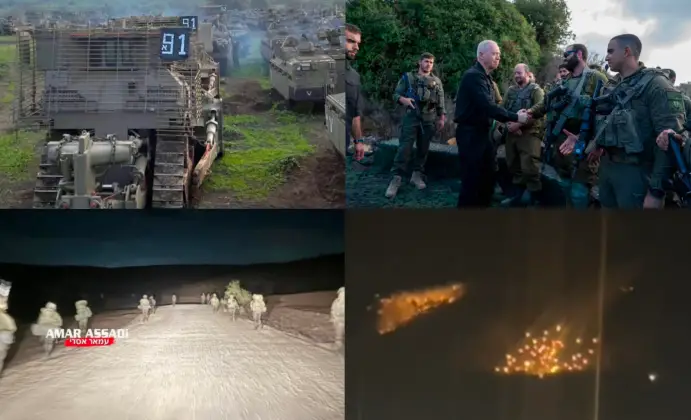<p >The Israel Defence Forces (IDF) from September 30 to October 1 launched a full scale invasion of neighbouring Lebanon, with the Lebanese Army and UN Peacekeepers withdrawing rapidly in the face of the oncoming forces. The IDF forces first declared the area on the border a closed military zone, and having hundreds of tanks and hundreds more other armoured vehicles positioned for attacks just across the border, it subsequently used tanks and artillery to very heavily bombard the Al Wazani and Al Khiam areas. Israeli forces were subsequently confirmed to have begun reconnaissance operations and deployed sappers to pave the way for advances, and to have deployed Apache attack helicopters to provide further fire support. This bombardment was later confirmed to be supported by the use of white phosphorus bombs, which was first confirmed to be used to target Kfar Shuba and Khalta. Broader advances were subsequently launched as part of the invasion effort.&nbsp;</p><p ><img src=" title="Hezbollah Paramilitary Units"></p><p >Following the full scale invasion footage showed special forces entering Lebanese territory, with sources confirming that Israeli armour infiltrated the Rmeish area. The invasion has been widely referred to in Israel as the beginning of a Third Lebanon War, and follows a prior failed invasion effort in 2006 during which Israeli forces were repelled by Hezbollah paramilitary units.&nbsp;Preceding the current invasion, Israeli and Hezbollah forces have exchanged fire with growing intensity, with Israeli bombing campaigns singling out the paramilitary group’s leadership. A&nbsp;<a href=" >strike on the bunker</a> of Hezbollah leader General Secretary Hassan Nasrallah on September 26 successfully eliminated much of the leadership, while also killing hundreds of civilians in the capital Beirut. Commander of Hezbollah’s Southern Front, Ali Karaki, had previously been targeted by air strike in a failed <a href=" >assassination attempt</a>&nbsp;on the evening of September 23, before subsequently being killed in Nasrallah’s bunker.</p><p >Hezbollah has launched large scale <a href=" >rocket artillery attacks</a> on key targets across Israel, including Ramat David Airbase which hosts three frontline squadrons of F-16 fighters, and Megiddo Military Airport which serves as a second staging base for F-16 operations. Also hit were Amos Base which serves as the main base for transportation and logistical support for northern Israel, an explosives factory in the Zichron, the main warehouses of the Northern Command at the Nimra Base, and other key targets. Israel has imposed an information blackout preventing reporting on the damage to its bases and other facilities.&nbsp;A more recent strike was reported on September 28 to have <a href=" target="_blank">destroyed</a> part of an Israeli David’s Sling long range air defence system.</p>
Israel Begins Invasion of Lebanon: Tanks, Artillery, Apaches and White Phosphorous Used For Full Scale Bombardment

